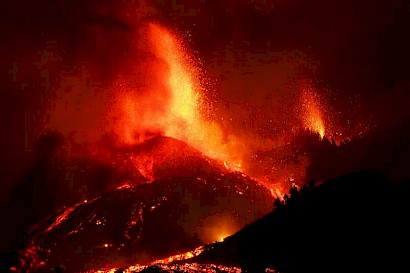La Palma volcano eruption: Warning signs may have been there for years
 The Cumbre Vieja volcano on Spain’s La Palma island fired back to life on Sunday after half a century of tranquility. As of 21 September, lava flows had covered more than 100 hectares, destroying more than 180 homes and displacing 6500 people.
The Cumbre Vieja volcano on Spain’s La Palma island fired back to life on Sunday after half a century of tranquility. As of 21 September, lava flows had covered more than 100 hectares, destroying more than 180 homes and displacing 6500 people.
Evacuation plans in affected areas began after swarms of mini-earthquakes occurred between 9 and 19 September, followed by areas of land that bulged upwards by more than 10 centimetres. But signs of an upcoming eruption may have already been detectable for more than a decade.
A team led by José Fernández Torres at the Institute of Geosciences in Spain published a study in January that showed that smaller land deformations in the island’s Aridane Valley had been appearing since 2009. Using a space-based radar system, the team detected land displacements of up to 5 centimetres, after taking into account other sources of land movement and atmospheric effects.
Signs of impending volcanic activity have been happening on La Palma for the past decade. Around 2010, levels of diffuse carbon dioxide began to increase in the island’s Dos Aguas spring, which also saw an increase in helium isotopes associated with magma. Spells of unexplained seismic activity came in October 2017 and February 2018, accompanied by an increase in thoron concentrations in soil. This isotope of radon is sometimes linked with seismic activity.
Combining these clues, Fernández and his colleagues concluded that the volcano had awoken from its slumber. They speculated that magma was pooling in a reservoir 8 to 10 kilometres below the surface, having crept up from depths of 25 to 30 kilometres.
“At the time of publication we informed the relevant authorities,” he says. However, his team had made it clear that an eruption wasn’t inevitable, as more than 80 per cent of magma intrusions don’t end in lava breaking through to the surface.
Now that the volcano is active, the study’s real value is that it tracked the volcano’s subtle deformations throughout its full reawakening. It is the first study of its kind for the Canary Islands, and could help to better predict future eruptions in this volcanically active region.
“For the people on La Palma I wish this had not happened, but it has created a fantastic scientific opportunity,” he says.
La Palma is the fifth largest of the eight main Canary Islands, and the last eruption on the island occurred in 1971 when lava spewed out of a cinder cone called Teneguía for three weeks, which is also located on the Cumbre Vieja mountain range.
About 20 kilometres north of the current eruption is the Roque de los Muchachos Observatory, home of several international telescopes. In a press release, the facility confirmed it had experienced minimal disruption given its altitude of nearly 2400 metres above sea level.
You can return to the main Market News page, or press the Back button on your browser.

